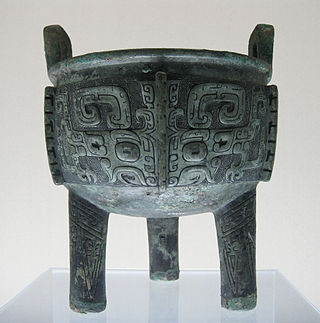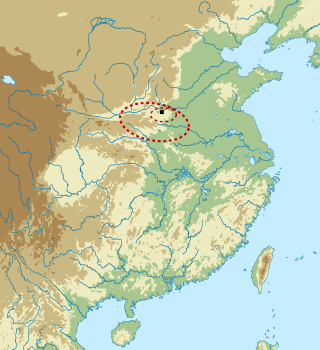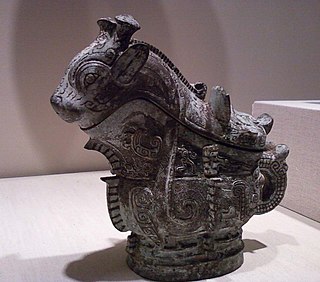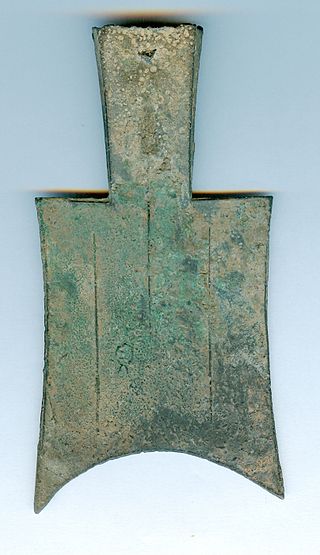
Chinese art is visual art that originated in or is practiced in China, Greater China or by Chinese artists. Art created by Chinese residing outside of China can also be considered a part of Chinese art when it is based on or draws on Chinese culture, heritage, and history. Early "Stone Age art" dates back to 10,000 BC, mostly consisting of simple pottery and sculptures. After that period, Chinese art, like Chinese history, was typically classified by the succession of ruling dynasties of Chinese emperors, most of which lasted several hundred years. The Palace Museum in Beijing and the National Palace Museum in Taipei contains extensive collections of Chinese art.

The zun or yi, used until the Northern Song (960–1126) is a type of Chinese ritual bronze or ceramic wine vessel with a round or square vase-like form, sometimes in the shape of an animal, first appearing in the Shang dynasty. Used in religious ceremonies to hold wine, the zun has a wide lip to facilitate pouring. Vessels have been found in the shape of a dragon, an ox, a goose, and more. One notable zun is the He zun from the Western Zhou.

Ding (鼎) are prehistoric and ancient Chinese cauldrons, standing upon legs with a lid and two facing handles. They are one of the most important shapes used in Chinese ritual bronzes. They were made in two shapes: round vessels with three legs and rectangular ones with four, the latter often called fangding. They were used for cooking, storage, and ritual offerings to the gods or to ancestors. The earliest recovered examples are pre-Shang ceramic ding at the Erlitou site but they are better known from the Bronze Age, particularly after the Zhou deemphasized the ritual use of wine practiced by the Shang kings. Under the Zhou, the ding and the privilege to perform the associated rituals became symbols of authority. The number of permitted ding varied according to one's rank in the Chinese nobility: the Nine Ding of the Zhou kings were a symbol of their rule over all China but were lost by the first emperor, Shi Huangdi in the late 3rd century BCE. Subsequently, imperial authority was represented by the Heirloom Seal of the Realm, carved out of the sacred Heshibi; it was lost at some point during the Five Dynasties after the collapse of the Tang.


A guang or gong is a particular shape used in Chinese art for vessels, originally made as Chinese ritual bronzes in the Shang dynasty, and sometimes later in Chinese porcelain. They are a type of ewer which was used for pouring rice wine at ritual banquets, and often deposited as grave goods in high-status burial. Examples of the shape may be described as ewers, ritual wine vessels, wine pourers and similar terms, though all of these terms are also used of a number of other shapes, especially the smaller tripod jue and the larger zun.

Chinese jade refers to the jade mined or carved in China from the Neolithic onward. It is the primary hardstone of Chinese sculpture. Although deep and bright green jadeite is better known in Europe, for most of China's history, jade has come in a variety of colors and white "mutton-fat" nephrite was the most highly praised and prized. Native sources in Henan and along the Yangtze were exploited since prehistoric times and have largely been exhausted; most Chinese jade today is extracted from the northwestern province of Xinjiang.

Ancient Chinese coinage includes some of the earliest known coins. These coins, used as early as the Spring and Autumn period (770–476 BCE), took the form of imitations of the cowrie shells that were used in ceremonial exchanges. The same period also saw the introduction of the first metal coins; however, they were not initially round, instead being either knife shaped or spade shaped. Round metal coins with a round, and then later square hole in the center were first introduced around 350 BCE. The beginning of the Qin dynasty (221–206 BCE), the first dynasty to unify China, saw the introduction of a standardised coinage for the whole Empire. Subsequent dynasties produced variations on these round coins throughout the imperial period. At first the distribution of the coinage was limited to use around the capital city district, but by the beginning of the Han dynasty, coins were widely used for such things as paying taxes, salaries and fines.

Sets and individual examples of ritual bronzes survive from when they were made mainly during the Chinese Bronze Age. Ritual bronzes create quite an impression both due to their sophistication of design and manufacturing process, but also because of their remarkable durability. From around 1650 BCE, these elaborately decorated vessels were deposited as grave goods in the tombs of royalty and the nobility, and were evidently produced in very large numbers, with documented excavations finding over 200 pieces in a single royal tomb. They were produced for an individual or social group to use in making ritual offerings of food and drink to his or their ancestors and other deities or spirits. Such ceremonies generally took place in family temples or ceremonial halls over tombs. These ceremonies can be seen as ritual banquets in which both living and dead members of a family were supposed to participate. Details of these ritual ceremonies are preserved through early literary records. On the death of the owner of a ritual bronze, it would often be placed in his tomb, so that he could continue to pay his respects in the afterlife; other examples were cast specifically as grave goods. Indeed, many surviving examples have been excavated from graves.

A hu is a type of wine vessel that has a pear-shaped cross-section. Its body swells and flares into a narrow neck, creating S-shaped profile. While it is similar to you vessel, hu usually has a longer body and neck. The shape of hu probably derives from its ceramic prototype prior to the Shang dynasty. They usually have handles on the top or rings attached to each side of neck. Many extant hu lack lids while those excavated in such tombs as Fu Hao's indicate that this type of vessel might be originally made with lids. Although it is more often to see hu having a circular body, there also appears hu in square and flat rectangular forms, called fang hu and bian hu in Chinese. In addition, hu often came to be found in a pair or in a set together with other types of vessels. As wine had played an important part in the Shang ritual, the hu vessel might be placed in the grave of an ancestor as part of ritual in order to ensure a good relationship with ancestor's spirit.

A jia is a ritual vessel type found in both pottery and bronze forms; it was used to hold libations of wine for the veneration of ancestors. It was made either with four legs or in the form of a tripod and included two pillar-like protrusions on the rim that were possibly used to suspend the vessel over heat. The earliest evidence of the Jia vessel type appears during the Neolithic Period. It was a prominent form during the Shang and early Western Zhou dynasties, but had disappeared by the mid-Western Zhou.

The Tomb of Marquis Yi of Zeng is an archaeological site in Leigudun Community (擂鼓墩社區), Nanjiao Subdistrict (南郊街道), Zengdu District, Suizhou, Hubei, China, dated sometime after 433 BC. The tomb contained the remains of Marquis Yi of Zeng, and is one of a handful of ancient Chinese royal tombs to have been discovered intact and then excavated using modern archaeological methods. Zeng was a state during the Spring and Autumn period of China. The tomb was made around 433 BC, either at the end of the Spring and Autumn period or the start of the Warring States period. The tomb comes from the end of the thousand-year-long period of the burial of large sets of Chinese ritual bronzes in elite tombs, and is also unusual in containing large numbers of musical instruments, including the great set of bells for which it is most famous.

A dui is a type of Chinese ritual bronze vessel used in the late Zhou dynasty and the Warring States period of ancient China. It was a food container used as a ritual vessel. Most dui consist of two bowls supported on three legs.

A gu is a type of ancient Chinese ritual bronze vessel from the Shang and Zhou dynasties. It was used to drink wine or to offer ritual libations.

A gui is a type of bowl-shaped ancient Chinese ritual bronze vessel used to hold offerings of food, probably mainly grain, for ancestral tombs. As with other shapes, the ritual bronzes followed early pottery versions for domestic use, and were recalled in later art in both metal, pottery, and sometimes stone. The shape changed somewhat over the centuries but constant characteristics are a circular form, with a rounded, wide, profile or shape from the side, standing on a narrower rim or foot. There are usually two, or sometimes four, handles, and there may be a cover or a square base.

An elaborately decorated "ritual wine server" in the guang shape is a Chinese ritual bronze wine vessel, accession number 60.43, in the permanent Asian collection at the Indianapolis Museum of Art. It dates to about 1100 BCE in the Shang dynasty period. The piece is currently on display in the Arthur R. & Frances D. Baxter Gallery of the museum.

Spade money was an early form of coin and commodity money used during the Zhou dynasty of China. Spade money was shaped like a spade or weeding tool, but the thin blade and small sizes of spade money indicate that it had no utilitarian function. The earlier versions of spade coins tended to have a fragile, hollow socket, reminiscent of a metal shovel. Later versions of spade money had this socket transformed into a thin, flat piece, and over time, inscriptions were added to the spade coins to mark their denominations. Several versions of spade money circulated across the Chinese Central Plains during the Zhou dynasty period until they were abolished by the Qin dynasty in 221 BC in favour of the Ban Liang cash coins.

The Kang Hou gui is a bronze vessel that is said to have been taken from the city of Huixian, Henan province, central China. Dating to the Western Zhou period, this ancient Chinese artefact is famous for its inscription on the bottom of the interior. It has been part of the British Museum's Asian Collections since 1977.

Yaozhou ware is a type of celadon or greenware in Chinese pottery, which was at its height during the Northern Song dynasty. It is the largest and typically the best of the wares in the group of Northern Celadon wares. It is especially famous for the rich effects achieved by decoration in shallow carving under a green celadon glaze which sinks into the depressions of the carving giving contrasts of light and dark shades.

The Eastern Zhou is a period of Chinese history, approximately the second half of the Zhou dynasty, following the Western Zhou period. Characterised by weak central government, it is subdivided into two periods: the Spring and Autumn, during which the ancient aristocracy still held power in a large number of separate polities, and the Warring States, which saw the consolidation of territory into a few domains and the dominance of other social classes. "Eastern" refers to the geographic situation of the royal capital, near present-day Luoyang.

A fangyi is a type of Chinese ritual bronze container typical of the Shang and early to middle Zhou periods of Bronze Age China. It takes the shape of a square or rectangular casket with a cover that resembles a hip roof, surmounted by a knob of a similar hipped appearance. The lower edge is typically indented with a semi-circular notch.





















